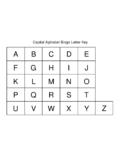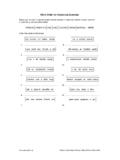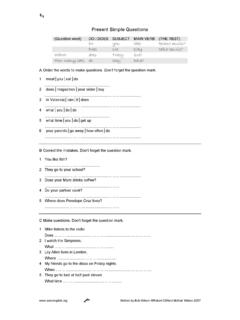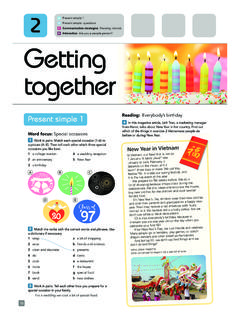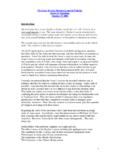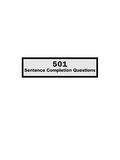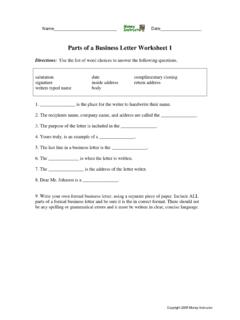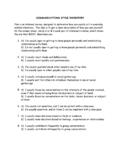Transcription of Phonics And Sight Word Exercises - mcedservices.com
1 Phonics And Sight Word ExercisesAt this time in the great debate about the best way to teach reading, both sides, thosewho advocate the teaching of Phonics and those who stress teaching Sight words , haveadmitted that they need each other. Those who believe that you need to know thesounds of the letters and be able to sound out words have admitted that there a quite afew words that aren t spelled phonetically and should be learned as Sight words . Theword who is a good example of this, because if sounded out it would be pronounced woe or woo. It s also evident that learning all words as Sight words is untenable,therefore, Sight word advocates admit that Phonics also has a role to play in learning wordsPre-literate students need to learn both Phonics and some Sight words . It s generallyaccepted as true that among the most common words there are many exceptions tophonics rules. Over 40% of the 100 most common words have irregular , that percentage goes down very quickly so that less than about 10% of themost common 1000 words have irregular spellings.
2 What does this mean for thoseteaching pre-literate students to read? It means that 100 to 200 of the most commonwords need to be learned as Sight words since they are so often have included flash cards to teach Sight recognition of the 210 most commonw o rds, in addition to the words needed to teach time, money, the calendar, and how tofill out forms. Work with a limited number of flash cards when you begin. When thes t u d e n t sare able to easily identify most of the words in the first group, add they can identify those words , have them practice saying the word and spellingthe word. Example: This word is the . It is spelled t-h-e. It helps to try, where possible, to put these words into context. Though clearly, at thebeginning level, it is hard to explain many of the structure words like the, of, the flash cards to make real sentences is possible. Many of the words can becombined to make questions. Examples of questions that can be made from the flashcards included are:What is her name?
3 Where is he from?What do they like?What did they make?Where did you go?Who did you see?Once students have learned to read and spell these words , you can mix up the flashcards and read individual words aloud for a dictation, or combine the words into questions for a dictation. You can also have students work with the flash cards to formtheir own questions. They can then copy those questions in their notebooks and writetheir own to the Flash Card Exercises for more specific examples of how to teach noted above, some Phonics rules need to be taught. Begin with the sounds of theletters. Using the alphabet flash cards, you can review the names of the letters and themost common sound each letter represents. It is best to teach short vowel sounds first,but it is certainly possible to teach a pair of short and long sounds for each students separate the alphabet flash cards into vowels and consonants. They canthen try to make words by combining letters. It s important to teach the idea that allwords must have at least one vowel.
4 Example: CAT is word but CDT is the flash cards, show letter combinations and ask students to decide if it is orisn t a : There is still some disagreement among educators about the use of nonsensew o rds to teach Phonics . As noted above, many of the most common words are irre g u l a raccording to Phonics rules and, to find words that fit Phonics rules and patterns, it isnecessary to use words that are uncommon. The Exercises here all use actual words ,but some of these words are not common and some are not easy to explain to studentswith limited English. It is important to remember that the focus here is to teach theconnections between sounds and letters more than vocabulary, and sometimes ateacher has to say, I m sorry, but I can t explain that word now. The Phonics Exercises included here begin by teaching consonant sounds, because theyare more consistent than vowel sounds. Each exercise starts with a set of 6 words . Example: Write the following words on the board where students can see the words to the students and have them listen and repeat.
5 Then point to thewords and have students practice reading the words off the board. When students can read the words comfortably, give them an exercise sheet with the short a vowel. The exercise sheets have the middle vowel already written. Example: Short a vowel sheet1. ____ a ____2. ____ a ____3. ____ a ____4. ____ a ____5. ____ a ____6. ____ a ____Read the practice words in the following order as a dictation:1. bad2. ban3. pan4. pack5. back6. padHave students fill in the initial and final consonants needed to complete the can do this as an individual or paired exercise . If students are working inpairs, one student can write the initial consonant and one student can write the are several Exercises for each vowel sheet, which lead students though a varietyof consonant sounds using short vowels. There are also some vowel sheets that focuso nlong vowel sounds. Unlike the short vowel sounds, long vowel sounds in Englishcan have variable spellings, heel and heal.
6 Sometimes the vowel sheet withthe final e already filled in should be used, and other times using the vowel sheetwith a single vowel will be necessary because of the variable spelling. The last groupof Exercises focuses on the distinction between short and long vowels. Example: Write the following words on the board where students can see students can read the words comfortably, give them an exercise sheet with the a vowel. The exercise sheets have the middle vowel already written. Example: a vowel sheet for short and long vowels1. ____ a ____ ____2. ____ a ____ ____3. ____ a ____ ____4. ____ a ____ ____5. ____ a ____ ____6. ____ a ____ ____Read the practice words in the following order as a mate2. hate3. rat4. mat5. rate6. hatHave students fill in the letters to complete the word. Students must decide if theword ends in a consonant or if it ends in a consonant and a vowel. Some of the blankswill not be filled vowel sheet masters, refer to the Student Vowel Sheets file.
7 For a variety ofword sets and dictations for use with each vowel sheet, refer to the Phonics WordSets file. These files can be downloaded and printed out as needed.
